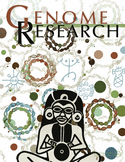Interspecies regulatory landscapes and elements revealed by novel joint systematic integration of human and mouse blood cell epigenomes
- Guanjue Xiang1,2,3,
- Xi He1,
- Belinda M. Giardine4,
- Kathryn J. Isaac5,
- Dylan J. Taylor5,
- Rajiv C. McCoy5,
- Camden Jansen4,
- Cheryl A. Keller4,
- Alexander Q. Wixom4,
- April Cockburn4,
- Amber Miller4,
- Qian Qi6,
- Yanghua He6,7,
- Yichao Li6,
- Jens Lichtenberg8,
- Elisabeth F. Heuston8,
- Stacie M. Anderson9,
- Jing Luan10,
- Marit W. Vermunt10,
- Feng Yue11,
- Michael E.G. Sauria12,
- Michael C. Schatz12,
- James Taylor5,12,†,
- Berthold Göttgens13,
- Jim R. Hughes14,
- Douglas R. Higgs14,
- Mitchell J. Weiss6,
- Yong Cheng6,
- Gerd A. Blobel10,
- David M. Bodine8,
- Yu Zhang15,
- Qunhua Li15,16,
- Shaun Mahony4,16,17 and
- Ross C. Hardison4,16,17
- 1Bioinformatics and Genomics Graduate Program, Huck Institutes of the Life Sciences, The Pennsylvania State University, University Park, Pennsylvania 16802, USA;
- 2Department of Data Science, Dana-Farber Cancer Institute, Boston, Massachusetts 02215, USA;
- 3Department of Biostatistics, Harvard T.H. Chan School of Public Health, Boston, Massachusetts 02215, USA;
- 4Department of Biochemistry and Molecular Biology, The Pennsylvania State University, University Park, Pennsylvania 16802, USA;
- 5Department of Biology, Johns Hopkins University, Baltimore, Maryland 21218, USA;
- 6Department of Hematology, St. Jude Children's Research Hospital, Memphis, Tennessee 38105, USA;
- 7Department of Human Nutrition, Food and Animal Sciences, University of Hawaìi at Mānoa, Honolulu, Hawaii 96822, USA;
- 8Genetics and Molecular Biology Branch, National Human Genome Research Institute, Bethesda, Maryland 20892, USA;
- 9Flow Cytometry Core, National Human Genome Research Institute, Bethesda, Maryland 20892, USA;
- 10Department of Pediatrics, Children's Hospital of Philadelphia, and Perelman School of Medicine, University of Pennsylvania, Philadelphia, Pennsylvania 19104, USA;
- 11Department of Biochemistry and Molecular Genetics, Feinberg School of Medicine, Northwestern University, Evanston, Illinois 60611, USA;
- 12Department of Computer Science, Johns Hopkins University, Baltimore, Maryland 21218, USA;
- 13Wellcome and MRC Cambridge Stem Cell Institute, University of Cambridge, Cambridge CB2 0AW, United Kingdom;
- 14MRC Weatherall Institute of Molecular Medicine, Oxford University, Oxford OX3 9DS, United Kingdom;
- 15Department of Statistics, The Pennsylvania State University, University Park, Pennsylvania 16802, USA;
- 16Center for Computational Biology and Bioinformatics, Genome Sciences Institute, Huck Institutes of the Life Sciences, The Pennsylvania State University, University Park, Pennsylvania 16802, USA;
- 17Center for Eukaryotic Gene Regulation, The Pennsylvania State University, University Park, Pennsylvania 16802, USA
Abstract
Knowledge of locations and activities of cis-regulatory elements (CREs) is needed to decipher basic mechanisms of gene regulation and to understand the impact of genetic variants on complex traits. Previous studies identified candidate CREs (cCREs) using epigenetic features in one species, making comparisons difficult between species. In contrast, we conducted an interspecies study defining epigenetic states and identifying cCREs in blood cell types to generate regulatory maps that are comparable between species, using integrative modeling of eight epigenetic features jointly in human and mouse in our Validated Systematic Integration (VISION) Project. The resulting catalogs of cCREs are useful resources for further studies of gene regulation in blood cells, indicated by high overlap with known functional elements and strong enrichment for human genetic variants associated with blood cell phenotypes. The contribution of each epigenetic state in cCREs to gene regulation, inferred from a multivariate regression, was used to estimate epigenetic state regulatory potential (esRP) scores for each cCRE in each cell type, which were used to categorize dynamic changes in cCREs. Groups of cCREs displaying similar patterns of regulatory activity in human and mouse cell types, obtained by joint clustering on esRP scores, harbor distinctive transcription factor binding motifs that are similar between species. An interspecies comparison of cCREs revealed both conserved and species-specific patterns of epigenetic evolution. Finally, we show that comparisons of the epigenetic landscape between species can reveal elements with similar roles in regulation, even in the absence of genomic sequence alignment.
Footnotes
-
[Supplemental material is available for this article.]
-
Article published online before print. Article, supplemental material, and publication date are at https://www.genome.org/cgi/doi/10.1101/gr.277950.123.
-
Freely available online through the Genome Research Open Access option.
- Received April 3, 2023.
- Accepted June 24, 2024.
This article, published in Genome Research, is available under a Creative Commons License (Attribution-NonCommercial 4.0 International), as described at http://creativecommons.org/licenses/by-nc/4.0/.











